Tritonia nelsonii
Tritonia nelsonii Baker
Family: Iridaceae
Common names: Nelson’s tritonia, stripe-leaf triton (Eng.)
Introduction
A breathtaking flowering plant which boasts vibrant orange-red flowers that bloom in late summer, adding delicate beauty and lovely colour to gardens and landscapes.
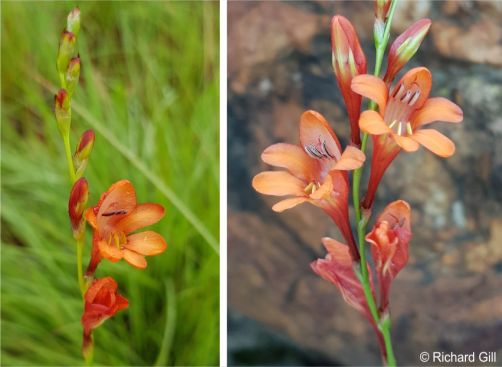
Description
Description
Tritonia nelsonii is an herbaceous, deciduous, perennial plant about 300 to 600 mm tall that grows from an underground storage organ, called a corm. The corm is almost spherical, about 15-30 mm in diameter and is covered with fine-textured fibrous tunics and sometimes has a papery neck. The stem is usually unbranched from the base, but sometimes has 2 branches from near the middle. It produces a loose fan of about 4 to 8 leaves that are simple, narrow, green, sword-shaped and twisted weakly towards the tips. Depending on the growing conditions and maintance, the leaf size varies typically around 100-300 mm long and about 2-4 mm wide. A significant feature of the leaves is that they are obviously marked with lines (striated), and the main vein and 3-4 secondary veins are equally prominent.
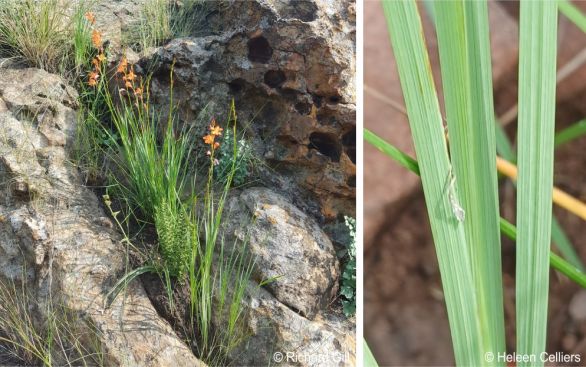
The inflorescence stalk produces a spike of about 5 to 12 reddish orange to vibrant red, funnel-shaped flowers, 10-15 mm long. The throat of the flowers is yellowish and pale and the lower petals each have a yellow spot surrounding a 2-4 mm high yellow peg-like protrusion. The petals are not of the same size. The top petal is usually paler inside and it is slightly hooded over the anthers (male reproductive part of a flower). The flowering period is in late summer (February to March). The fruit is a small capsule that holds a number of seeds inside.
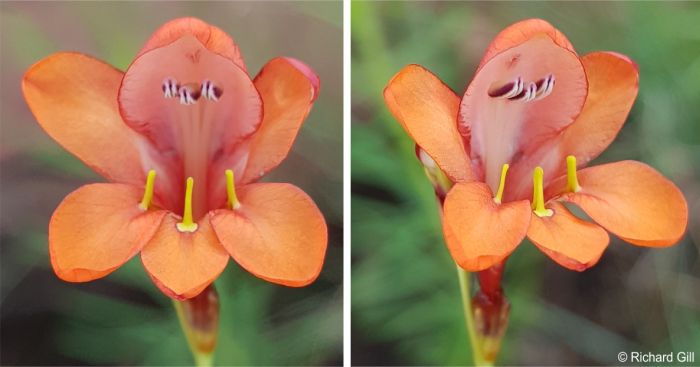
Conservation Status
Status
Tritonia nelsonii is not threatened in its natural habitat, thus its conservation status is Least Concern (LC) according to the Red List of South African Plants.
Distribution and habitat
Distribution description
Tritonia nelsonii occurs only in southern Africa, and nowhere else in the world. In South Africa, it occurs in Limpopo, Mpumalanga, North West and Gauteng Provinces, between the Soutpansberg, Waterval Boven, Zeerust and Heidelberg. It grows in rocky grasslands and savanna in well-drained, often quartzitic soil, and often wedged between rocks and in crevices.
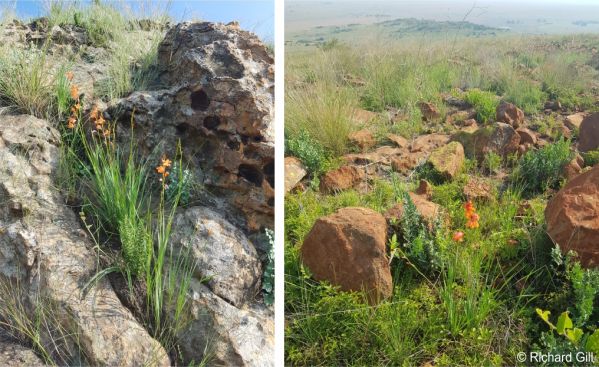
Derivation of name and historical aspects
History
The English botanist, J.B. Ker Gawler, is the one who brought the genus Tritonia into being in 1802. He named it from the Latin word triton, which is a weather vane, due to the inconsistent arrangement of the stamens in some species. This species is named after the botanist, nurseryman and collector, William Nelson, who collected the type specimen in 1880. Tritonia nelsonii was described in 1892, by John Gilbert Baker, a well-known English botanist who worked extensively on the South African flora, especially on the Iridaceae family.
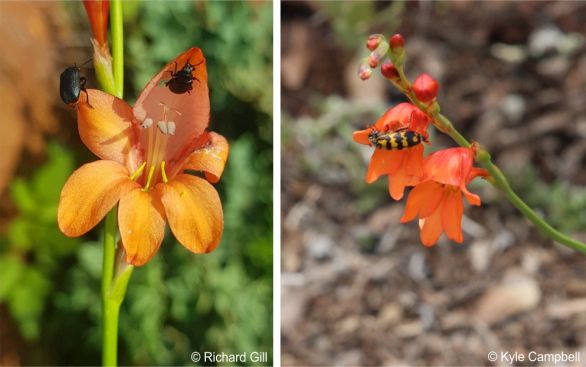
Ecology
Ecology
Tritonia nelsonii flowers are pollinated by Long-tongued Bees foraging for nectar. There is also evidence of Blister Beetles and Ebony Beetles visiting the flowers, they could also play a role in pollination. After pollination, the ovary swells up and forms a capsule. The capsule then dries out and splits open when mature, and the seeds are dispersed by wind as it shakes the capsules.
This Tritonia species is well adapted to the summer-rainfall climate of the northern interior of South Africa, which sometimes experiences frost in winter. In order to survive the frosty and dry conditions, they shed their above ground parts and go dormant in winter. They will then remain dormant throughout winter and resprout again in spring.
Uses
Use
This Tritonia species can be used in horticulture as a pot plant. Since they are solitary plants, it is best to plant them closely together, in dense clumps or massed, to get the best effect in the garden.
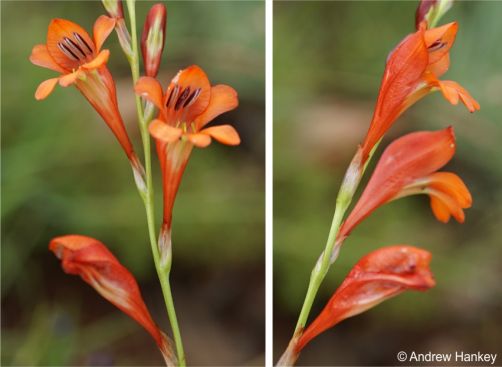
Growing Tritonia nelsonii
Grow
Tritonia nelsonii can be easily propagated by seeds. Sow seeds anytime between spring and summer, cover them with a 3-5 mm layer of medium and they will germinate in 2-3 weeks. Use a 50:50 mix of sieved potting soil or compost and silica sand or river sand. The corms need good drainage otherwise they will rot.
They can be planted in pots or directly in the ground, in either full sun or semi-shade, in well-drained, humus-rich soil. Plant the corms very closely together, about 5 cm apart and 4 cm deep. They need regular heavy drenching during the the summer growing season but after flowering, when the leaves start dying back, it is best to cease watering the bulbs and keep them dry during the winter to avoid bulb rot.
At Walter Sisulu National Botanical Garden, we keep all cormous plants out of reach from our resident porcupines which eat corms, bulbs and tubers. Even though the corms are quite small, it is possible that mass planting might attract porcupines.
References
- Baker, J.G. 1892. Tritonia nelsonii. Handbook of Irideae. p.195-196. https://www.biodiversitylibrary.org/page/15305793#page/211/mode/1up.
- Cambell, K. 2025. Observation of Tritonia nelsonii, West Rand, Gauteng. iNaturalist. Online. https://www.inaturalist.org/observations/258239314.
- Celliers, H. 2025. Observation of Tritonia nelsonii, Witbank. iNaturalist. Online. https://www.inaturalist.org/observations/265142958.
- Duncan, G. 2010. Grow bulbs. A guide to the cultivation of bulbs of South Africa and neighboring countries. Kirstenbosch Gardening Series. South African National Biodiversity Institute, Cape Town.
- Duncan. G.D. 2008. Tritonia crocata (L.) Ker Gawl. (Iridaceae). PlantZAfrica. Online. https://pza.sanbi.org/tritonia-crocata.
- Foden, W., Potter, L. & Patel, T. 2021. Tritonia nelsonii Baker. National Assessment: Red List of South African Plants. https://redlist.sanbi.org/species.php?species=1537-34.
- Gill, K. & Engelbrecht, A. 2012. Wildflowers of the Magaliesberg. Kevin Gill, Sandton.
- Gill, R. 2025. Observations of Tritonia nelsonii. iNaturalist. Online. https://www.inaturalist.org/observations?taxon_id=595743&user_id=richardgill&verifiable=any.
- Glen, H.F. & Germishuizen, G. (compilers). 2010. Botanical exploration of southern Africa, edition 2. Strelitzia 26. South African National Biodiversity Institute, Pretoria.
- Goldblatt, P. & Manning, J.C. 2020. Iridaceae of southern Africa. Strelitzia 42. South African National Biodiversity Institute, Pretoria.
- Hankey, A. 2019. Observation of Tritonia nelsonii, Krugersdorp. iNaturalist. Online. https://www.inaturalist.org/observations/22599825.
Credits
Dineo Dibakwane and Halala Hlabisa
Walter Sisulu National Botanical Garden
June 2025
Acknowledgements: the authors thank Richard Gill, Kyle Campbell, Andrew Hankey and Heleen Celliers for the photos.
Plant Attributes:
Plant Type: Bulb
SA Distribution: Gauteng, Limpopo, Mpumalanga, North West
Soil type: Sandy, Loam
Flowering season: Early Summer, Late Summer, Autumn
PH: Acid, Neutral
Flower colour: Orange
Aspect: Full Sun
Gardening skill: Average
Special Features:
Horticultural zones
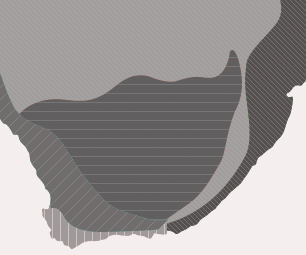








Rate this article
Article well written and informative
Rate this plant
Is this an interesting plant?
Login to add your Comment
Back to topNot registered yet? Click here to register.